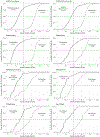Heterogeneity of CFTR modulator-induced sweat chloride concentrations in people with cystic fibrosis
- PMID: 38360461
- PMCID: PMC11322419
- DOI: 10.1016/j.jcf.2024.02.001
Heterogeneity of CFTR modulator-induced sweat chloride concentrations in people with cystic fibrosis
Abstract
Background: Sweat chloride (SC) concentrations in people with cystic fibrosis (PwCF) reflect relative CF transmembrane conductance regulator (CFTR) protein function, the primary CF defect. Populations with greater SC concentrations tend to have lesser CFTR function and more severe disease courses. CFTR modulator treatment can improve CFTR function within specific CF genotypes and is commonly associated with reduced SC concentration. However, SC concentrations do not necessarily fall to concentrations seen in the unaffected population, suggesting potential for better CFTR treatment outcomes. We characterized post-modulator SC concentration variability among CHEC-SC study participants by genotype and modulator.
Methods: PwCF receiving commercially approved modulators for ≥90 days were enrolled for a single SC measurement. Clinical data were obtained from chart review and the CF Foundation Patient Registry (CFFPR). Variability of post-modulator SC concentrations was assessed by cumulative SC concentration frequencies.
Results: Post-modulator SC concentrations (n = 3787) were collected from 3131 PwCF; most (n = 1769, 47 %) were collected after elexacaftor/tezacaftor/ivacaftor (ETI) treatment. Modulator use was associated with lower SC distributions, with post-ETI concentrations the lowest on average. Most post-ETI SC concentrations were <60 mmol/L (79 %); 26 % were <30 mmol/L. Post-ETI distributions varied by genotype. All genotypes containing at least one F508del allele had individuals with post-ETI SC ≥60 mmol/L, with the largest proportion being F508del/minimal function (31 %).
Conclusions: Post-modulator SC concentration heterogeneity was observed among all genotypes and modulators, including ETI. The presence of PwCF with post-modulator SC concentrations within the CF diagnostic range suggests room for additional treatment-associated CFTR restoration in this population.
Keywords: CFTR function; CFTR modulators; Epidemiology; Sweat chloride.
Copyright © 2024 European Cystic Fibrosis Society. Published by Elsevier B.V. All rights reserved.
Conflict of interest statement
Declaration of competing interest The authors declare that they have no known competing financial interests or personal relationships that could have appeared to influence the work reported in this paper.
Figures




Similar articles
-
Vanzacaftor-tezacaftor-deutivacaftor versus elexacaftor-tezacaftor-ivacaftor in individuals with cystic fibrosis aged 12 years and older (SKYLINE Trials VX20-121-102 and VX20-121-103): results from two randomised, active-controlled, phase 3 trials.Lancet Respir Med. 2025 Mar;13(3):256-271. doi: 10.1016/S2213-2600(24)00411-9. Epub 2025 Jan 2. Lancet Respir Med. 2025. PMID: 39756424 Free PMC article. Clinical Trial.
-
Evaluation of elexacaftor-tezacaftor-ivacaftor treatment in individuals with cystic fibrosis and CFTRN1303K in the USA: a prospective, multicentre, open-label, single-arm trial.Lancet Respir Med. 2024 Dec;12(12):947-957. doi: 10.1016/S2213-2600(24)00205-4. Epub 2024 Aug 26. Lancet Respir Med. 2024. PMID: 39208836
-
Corrector therapies (with or without potentiators) for people with cystic fibrosis with class II CFTR gene variants (most commonly F508del).Cochrane Database Syst Rev. 2023 Nov 20;11(11):CD010966. doi: 10.1002/14651858.CD010966.pub4. Cochrane Database Syst Rev. 2023. PMID: 37983082 Free PMC article.
-
Real-world effectiveness and safety of elexacaftor/tezacaftor/ivacaftor in cystic fibrosis patients with Phe508del -gating and -residual function genotypes.Respir Med. 2025 Aug-Sep;245:108221. doi: 10.1016/j.rmed.2025.108221. Epub 2025 Jun 24. Respir Med. 2025. PMID: 40571167
-
Pharmacokinetics of Ivacaftor, Tezacaftor, Elexacaftor, and Lumacaftor in Special Cystic Fibrosis Populations: A Systematic Review.Clin Pharmacokinet. 2025 Jul;64(7):999-1046. doi: 10.1007/s40262-025-01507-2. Epub 2025 May 21. Clin Pharmacokinet. 2025. PMID: 40399734 Free PMC article.
Cited by
-
VX-445 (elexacaftor) inhibits chloride secretion across human bronchial epithelial cells by directly blocking KCa3.1 channels.PNAS Nexus. 2025 Jul 4;4(7):pgaf211. doi: 10.1093/pnasnexus/pgaf211. eCollection 2025 Jul. PNAS Nexus. 2025. PMID: 40688096 Free PMC article.
-
Progress of personalized medicine of cystic fibrosis in the times of efficient CFTR modulators.Mol Cell Pediatr. 2025 May 5;12(1):6. doi: 10.1186/s40348-025-00194-0. Mol Cell Pediatr. 2025. PMID: 40320452 Free PMC article. Review.
-
Genetic Heterogeneity Correlated with Phenotypic Variability in 48 Patients with Cystic Fibrosis.J Clin Med. 2025 Jul 29;14(15):5362. doi: 10.3390/jcm14155362. J Clin Med. 2025. PMID: 40806984 Free PMC article.
-
Case Report: A delicate equilibrium of exocrine pancreatic recovery and hepatotoxicity with elexacaftor/tezacaftor/ivacaftor therapy in a pediatric patient with cystic fibrosis.Front Pediatr. 2024 Oct 23;12:1457517. doi: 10.3389/fped.2024.1457517. eCollection 2024. Front Pediatr. 2024. PMID: 39507496 Free PMC article.
-
Vanzacaftor-tezacaftor-deutivacaftor versus elexacaftor-tezacaftor-ivacaftor in individuals with cystic fibrosis aged 12 years and older (SKYLINE Trials VX20-121-102 and VX20-121-103): results from two randomised, active-controlled, phase 3 trials.Lancet Respir Med. 2025 Mar;13(3):256-271. doi: 10.1016/S2213-2600(24)00411-9. Epub 2025 Jan 2. Lancet Respir Med. 2025. PMID: 39756424 Free PMC article. Clinical Trial.
References
-
- Stoltz DA, Meyerholz DK, Welsh MJ. Origins of cystic fibrosis lung disease. N Engl J Med. 2015;372(16):1574–5. - PubMed
-
- Farrell PM, White TB, Ren CL, Hempstead SE, Accurso F, Derichs N, et al. Diagnosis of Cystic Fibrosis: Consensus Guidelines from the Cystic Fibrosis Foundation. J Pediatr. 2017;181S:S4–S15 e1. - PubMed
-
- McKone EF, Velentgas P, Swenson AJ, Goss CH. Association of sweat chloride concentration at time of diagnosis and CFTR genotype with mortality and cystic fibrosis phenotype. J Cyst Fibros. 2015;14(5):580–6. - PubMed
-
- Heijerman HGM, McKone EF, Downey DG, Van Braeckel E, Rowe SM, Tullis E, et al. Efficacy and safety of the elexacaftor plus tezacaftor plus ivacaftor combination regimen in people with cystic fibrosis homozygous for the F508del mutation: a double-blind, randomised, phase 3 trial. Lancet. 2019;394(10212):1940–8. - PMC - PubMed
MeSH terms
Substances
Grants and funding
LinkOut - more resources
Full Text Sources
Medical

